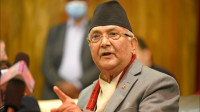National
Nepal's problem with students flocking to Australia is so bad even Australians are concerned
In a report published by Sydney Morning Herald, leading education experts say the pressure to pay for tuition leads students to be exploited.
Binod Ghimire
In little over two years, 65,746 Nepali students have enrolled in tertiary education in Australia, and according to Australian education experts, that is a cause for concern.
The overwhelmingly large number of students has made Nepal the third-largest source of foreign students in Australia, behind China and India. But given that Nepal is a largely poor country with a relatively small population, experts say the growing volume of students is not good news.
In a report published by the Sydney Morning Herald on Sunday, leading Australian education experts have warned that “it is unlikely the [Nepali] students can genuinely afford to study in Australia, and are likely involved in exploitative work to pay for their tuition.”
This account was corroborated to the Post by students who are currently in Australia. According to Bijay Sapkota, former president of the Council of International Students Australia, most Nepali students depend on work to fund their studies.
“Those who desperately need work are more likely to get exploited,” Sapkota told the Post over the phone from Sydney.
According to the Herald, there is a 50-50 split in Nepali students who choose higher education in Australia—half choose university education while half are pursuing vocational training.
Education consultancies say that more students are choosing vocational training because it is easier and cheaper to study, and while pursuing their studies, they can work on the side to make money.
“We have been raising the issue for quite some time,” said Kumar Karki, former chairperson of International Education Representative Initiative of Nepal, an umbrella body of education consultancies in Nepal. “The unnatural outflux has to be controlled sooner or later.”
Already, the visa success rate of Nepali students, particularly those opting for vocational education is decreasing, said Karki.
Australia is a major destination for Nepali students, primarily because of its relatively loose visa regulations when compared to the US or Europe. Students are also allowed to work up to 40 hours in a fortnight during semesters and full-time during breaks. Australia even allows secondary applicants for spouses on visas, which means students can bring their partners with them.
Over 60 percent of students acquiring No Objection Certificates, a government-issued document required as a clearance to study abroad, are for Australia, according to records from the Ministry of Education.
Ram Sharan Sapkota, joint-secretary at the Ministry of Education, said that they cannot stop issuing certificates for students without reason, even if they know many students cannot fund their education without working there for long hours and in exploitative conditions. The earnings from 40 hours a fortnight is generally not enough to cover university fees, let alone room and board.
“It’s a fact that not all students are travelling abroad solely for education,” said Sapkota. “However, we cannot stop them if they have the required documentation.”
The Australian Embassy in Nepal also said that Nepali students need to understand that 40 hours of work per fortnight is not adequate to cover all expenses and that students must have sufficient financial means of their own.
“The Embassy strongly encourages all prospective students to carry out their independent research on their planned education provider, study program, living arrangements, tuition and living costs, and all other factors before committing to a course of study in Australia,” said the embassy in an email response to the Post.
Earlier this year, hundreds of Nepali students enrolled in an Australian technical institution were left in limbo after the country’s regulator for vocational and training sector deregistered the college for failing to abide by existing regulations.
The Australian Skills Quality and Authority the regulatory body in February revoked the vocational education and training accreditation of the Australia Institute of Business and Technology, where around 90 percent of the 1,000 nursing students enrolled were Nepalis. The decision of the authority was later overturned by a court order.
The number of Nepali students in Australia has grown by three times since 2016 when the size was around 21,000. Nepali students contributed around $2.6 billion to the Australian economy in 2018/19, up from $1.6 billion the previous year, according to the newspaper.




 5.39°C Kathmandu
5.39°C Kathmandu










%20(1).jpg&w=300&height=200)



